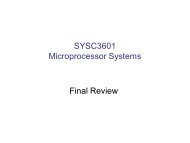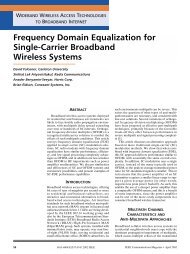Image Reconstruction for 3D Lung Imaging - Department of Systems ...
Image Reconstruction for 3D Lung Imaging - Department of Systems ...
Image Reconstruction for 3D Lung Imaging - Department of Systems ...
Create successful ePaper yourself
Turn your PDF publications into a flip-book with our unique Google optimized e-Paper software.
13<br />
12<br />
14<br />
V<br />
V<br />
V<br />
11<br />
15<br />
V<br />
V<br />
V<br />
10<br />
16<br />
V<br />
9<br />
(a) First <strong>of</strong> 16 drive pairs<br />
1<br />
V<br />
8<br />
V<br />
2<br />
7<br />
V<br />
3<br />
V<br />
V<br />
V<br />
6<br />
4<br />
5<br />
13<br />
12<br />
14<br />
V<br />
V<br />
V<br />
11<br />
15<br />
V<br />
V<br />
V<br />
10<br />
16<br />
V<br />
V<br />
9<br />
(b) Second <strong>of</strong> 16 drive pairs<br />
Figure 6.1: 2D Adjacent drive patterns. In figure 6.1(a) current is injected through electrode<br />
pair (1,2) and the resulting boundary voltage differences are measured from electrode pairs<br />
(3,4),(4,5),...,(14, 15),(15,16). Voltages are not measured between pairs (16,1),(1,2), or<br />
(2,3). In figure 6.1(b) the current is injected between pair (2,3), and the voltage differences<br />
measured between pairs (4,5),(5,6),...,(15, 16),(16,1). Voltages are not measured between<br />
pairs (1,2),(2,3), or (3,4).<br />
applications, in which one wants to obtain more accurate tomographic slices through the<br />
chest.<br />
6.2 Methods<br />
We consider EIT difference imaging, which is widely understood to improve reconstructed<br />
image stability in the presence <strong>of</strong> problems such as unknown contact impedance, inaccurate<br />
electrode positions, nonlinearity, and in the 2D case, the use <strong>of</strong> 2D approximations <strong>for</strong><br />
<strong>3D</strong> electrical fields [17][87]. We address the class <strong>of</strong> normalized one-step linearized reconstruction<br />
algorithms that calculate the change in a finite element conductivity distribution,<br />
x = σ2 − σ1 due to a change in EIT difference signal, z = v2 − v1 over a time interval<br />
(t1,t2). By convention we consider the signal at t1 to be the reference frame and the signal<br />
at t2 to be the data frame. Since we do not know σ1, x is interpreted as the change in<br />
conductivity with respect to the unknown initial conductivity x = ∆σ = σ2 − σ1.<br />
For small changes around a background conductivity the relationship between x and z<br />
may be linearized as<br />
z = Hx + n (6.1)<br />
where H is the Jacobian or sensitivity matrix and n is the measurement system noise,<br />
assumed to be uncorrelated additive white Gaussian (AWGN). Each element i, j, <strong>of</strong> H is<br />
calculated as Hij = ∂zi<br />
�<br />
�<br />
and relates a small change in the ith difference measurement to<br />
� ∂xj σ0<br />
a small change in the conductivity <strong>of</strong> jth element. H is a function <strong>of</strong> the FEM, the current<br />
injection pattern, and the background conductivity. We use a homogenous background<br />
conductivity in which σ0 = 1 <strong>for</strong> each <strong>of</strong> the elements.<br />
79<br />
1<br />
V<br />
8<br />
V<br />
2<br />
7<br />
V<br />
3<br />
V<br />
V<br />
6<br />
4<br />
5





